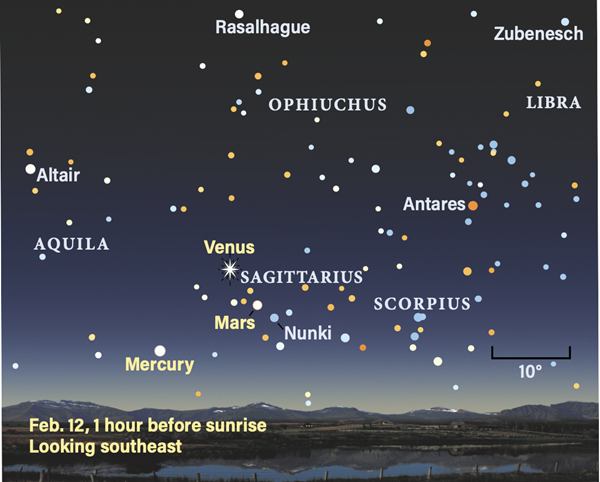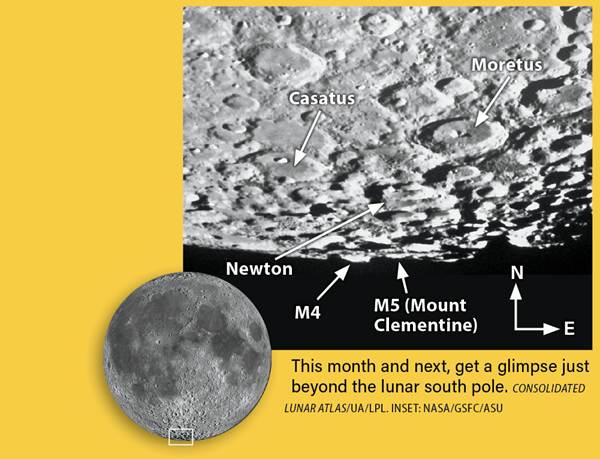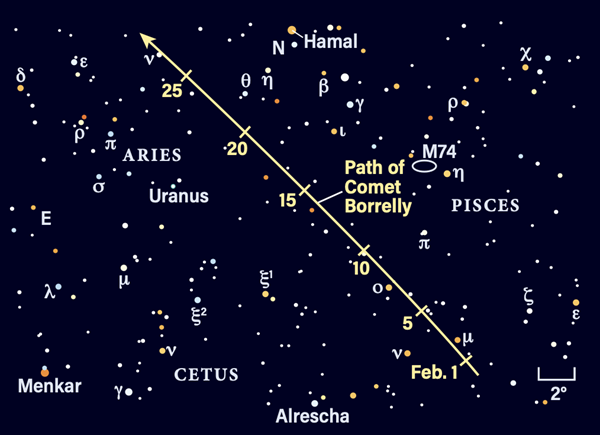
The just-past-Full Moon sets over snowy Yellowstone National Park in February 2017.
Friday, February 11
Jupiter and Neptune hang in the western sky this evening after the Sun has set. If you’re going to observe them, opt for Jupiter first. The solar system’s largest world will set roughly an hour after the Sun, affording less time to view it, particularly before it sinks too low into the thicker, more turbulent air near the horizon.
Jupiter glows at magnitude –2, making it easy to find as the sky grows dark. It sits smack dab in the middle of Aquarius, just over 2° below magnitude 3.7 Hydor (Lambda [λ] Aquarii). Tonight, the planet’s disk spans 33" and is accompanied by all four of its Galilean moons, but these may be difficult to pick out with a bright background and potentially poor seeing.
Once the sky grows a bit darker and good prospects for Jupiter are gone, look 12° northeast of the giant planet to find 8th-magnitude Neptune. You’ll need binoculars or a telescope to spot it, less than 4.5° northeast of 6th-magnitude Phi (ϕ) Aquarii. Neptune sets about three hours after the Sun, so there’s a bit more time to enjoy this distant world through your eyepiece.
Sunrise: 6:58 A.M.
Sunset: 5:32 P.M.
Moonrise: 12:47 P.M.
Moonset: 3:37 A.M.
Moon Phase: Waxing gibbous (78%)
*Times for sunrise, sunset, moonrise, and moonset are given in local time from 40° N 90° W. The Moon’s illumination is given at 12 P.M. local time from the same location.
Saturday, February 12

Venus’ big day: Venus shares the morning sky with Mercury and Mars on Feb. 12, when it reaches greatest brilliancy.
Venus officially reaches greatest brilliancy when it is 26 percent lit. That moment occurs at 1 P.M. EST today.
Earth’s sister planet is blazing at magnitude –4.9 in the southeastern sky before dawn this morning. Venus rises around 4:30 A.M. local time but, because it’s so bright, you can observe it far into twilight as sunrise approaches — just make sure to put away your binoculars or telescope a few minutes before local sunrise to prevent accidental (and serious) damage to your eyes.
The planet is not often quite this bright at greatest brilliancy — typically it reaches only magnitude –4.5. But this time around, Venus is a bit closer to Earth than usual — only 38 million miles (61 million kilometers) — resulting in greater brightness.
Venus also passes 7° north of Mars later today at 8 P.M. EST. This morning, the two planets are roughly the same distance apart, both floating just north of the handle of the Teapot asterism in Sagittarius. Mars shines a much dimmer magnitude 1.3 and, through a telescope, its 4"-wide disk appears 95 percent lit.
Sunrise: 6:56 A.M.
Sunset: 5:33 P.M.
Moonrise: 1:36 P.M.
Moonset: 4:32 A.M.
Moon Phase: Waxing gibbous (85%)
Sunday, February 13
The quickly waxing Moon floats in Gemini tonight, hanging near its two bright stars Castor and Pollux. Let’s seek out another bright target tonight: The brightest, in fact, if you’re taking about stars! Sirius, also cataloged as Alpha (α) Canis Majoris and sometimes called the Dog Star, is the brightest star in the northern sky. A beacon at magnitude –1.4, you can’t miss it as it climbs above the southeastern horizon, already more than 20° high an hour after sunset.
Although it’s easy to see this star with the naked eye, try inspecting it with binoculars or a telescope, particularly early in the evening. That’s when Sirius will be most affected by motion within Earth’s atmosphere, causing it to scintillate, or twinkle. Although astronomers try to avoid this effect when studying targets, the results can be visually stunning. You may see the star appear to both dance in place and alternate through a wide range of vivid hues, almost like a color-changing LED light. Take a look — you won’t be disappointed!
Sunrise: 6:55 A.M.
Sunset: 5:34 P.M.
Moonrise: 2:30 P.M.
Moonset: 5:22 A.M.
Moon Phase: Waxing gibbous (92%)
Monday, February 14

This month, skywatchers are getting something special: a glimpse beyond the lunar south pole. You’re looking for Mount Clementine, officially known only as M5. It’s one of the easiest farside features to see and spends most of each lunar month in continuous sunlight.
Starting tonight and returning over the next several nights, pull out your telescope and aim it at the southern regions of our satellite. You’ll immediately notice the fantastic 3D look of the lunar limb. Because the Moon is sitting just above the Earth-Sun plane, called the ecliptic, we get a peek at features past the pole that we normally don’t get to see. You’ll observe rugged terrain that casts sharp black shadows; these pools of darkness stretch southward as lunar noon approaches.
Use our guide above to locate both Mount Clementine and a neighboring feature, M4. The craters Casatus, Moretus, and Newton should help you make sure you’re in the right spot. Watch from day to day as these mountains’ shadows move with the changing Sun angle. If the glare is too bright, bump up the magnification — this reduces the amount of the lunar surface you’re viewing and cuts down on its reflected light as well.
Sunrise: 6:54 A.M.
Sunset: 5:35 P.M.
Moonrise: 3:31 P.M.
Moonset: 6:05 A.M.
Moon Phase: Waxing gibbous (96%)
Tuesday, February 15
A few hours before sunrise, the Moon is setting in Cancer the Crab. Turn your gaze instead across the sky and look up to find the constellation Boötes high overhead in the south. This star figure is home to another of the sky’s brightest stars: magnitude –0.1 Arcturus, a red giant star in the later stages of its life. Does its glow appear orange or red to you, especially compared with its nearby neighbors?
Just over 10° northeast of Arcturus is magnitude 2.6 Izar (Epsilon [ϵ] Boötis). This target is a beautiful binary star some 200 light-years away, consisting of components colored orange and white. The stars are separated by about 3" and typically require a telescope 3 inches or larger to resolve.
Not only is this pair stunning to look at, it also offers a glimpse at stellar evolution in action. Today, the older, orange-hued star is roughly 4 times the mass of the Sun, while the younger, whiter star is just 2 solar masses. But over time, that more massive star will blow off its outer layers and become a smaller, less massive white dwarf — and by then, the younger star will have swollen up to become an orangey red giant instead.
Sunrise: 6:53 A.M.
Sunset: 5:36 P.M.
Moonrise: 4:35 P.M.
Moonset: 6:43 A.M.
Moon Phase: Waxing gibbous (99%)
Wednesday, February 16
February’s Full Moon occurs today at 11:56 A.M. EST. This month’s Full Moon is called, perhaps appropriately for much of the U.S., the Snow Moon. Its bright light will wash out much of the sky overnight, as the Full Moon rises and sets opposite the Sun.
But all is not lost, even in a brighter sky. The planet Mercury reaches greatest western elongation from the Sun (26°) at 4 P.M. EST; it’s visible early this morning before sunrise, clearing the horizon around 5:30 A.M. local time. Mercury currently sits in Capricornus and is now magnitude 0.1, having brightened from magnitude 0.9 early in February. It won’t get much brighter in the coming weeks, though, reaching magnitude 0 by the 20th and –0.1 by the end of the month.
The innermost planet’s tiny disk spans 7" through a telescope and appears 60 percent lit. You’ll find it to the lower left (east) of brighter Venus and Mars, still in Sagittarius and rising around 4:20 A.M. and 4:50 A.M. local time, respectively.
Sunrise: 6:51 A.M.
Sunset: 5:37 P.M.
Moonrise: 5:41 P.M.
Moonset: 7:15 A.M.
Moon Phase: Full
Thursday February 17
Dwarf planet 1 Ceres rules the asteroid belt, and all month it’s flying through Taurus the Bull. Tonight you’ll find the small world, which currently glows around magnitude 8.5, less than 4° southeast of the Pleiades (M45). You should be able to follow it even from the city if you’ve got a scope measuring just 3 inches or more.
Once you’ve spotted Ceres, don’t forget to turn toward the Pleiades to enjoy the view. Although this cluster is also called the Seven Sisters, there are hundreds of stars within it, nine of which crack magnitude 6. Tonight’s bright moonlight might affect how many stars you can easily see, particularly without any optical aid. Consider jotting down a quick sketch and returning when there is no Moon in the sky to see if the number of visible luminaries has changed. If you want to magnify the view, binoculars or that same low-power scope you used to spy Ceres are best. In fact, your ideal tool might be the finder scope on your telescope! That’s because the Pleiades covers roughly 110' on the sky, although its brightest nine stars will all fit within a 1°-wide field of view.
Sunrise: 6:50 A.M.
Sunset: 5:39 P.M.
Moonrise: 6:47 P.M.
Moonset: 7:43 A.M.
Moon Phase: Waning gibbous (99%)
Friday, February 18

Comet Borrelly tracks from Pisces into Aries as February progresses, passing the 9th-magnitude face-on spiral galaxy M74 along the way. The position of Uranus is shown on Feb. 15.
Comet 19P/Borrelly is currently working its way through Aries the Ram. Tonight, the comet is 6° southeast of magnitude 2.6 Sheratan (Beta [β] Arietis). Borrelly has recently been reported around magnitude 9; a 4-inch scope will do the trick under extremely dark skies if you want to simply pick it up, but larger scopes and higher magnifications are best if you want to bring out detail on this icy fuzzball. An 8-inch scope at 150x will more likely show the broad tail spreading out to the south.
There are several added bonuses in the area: magnitude 5.8 Uranus sits 5.5° east of Borrelly, while the 9th-magnitude face-on spiral galaxy M74 sits about 8.5° west, over the border in Pisces. This fainter target might be challenging in the bright moonlight, so consider returning after the Moon has waxed and no longer washes out the nighttime sky. The comet will continue northeast in the days to come, sliding past brighter Hamal (magnitude 2 Alpha Arietis) and coming a bit closer to Uranus, which remains in roughly the same location all month.
Sunrise: 6:49 A.M.
Sunset: 5:40 P.M.
Moonrise: 7:53 P.M.
Moonset: 8:09 A.M.
Moon Phase: Waning gibbous (95%)
Source: astronomy.com